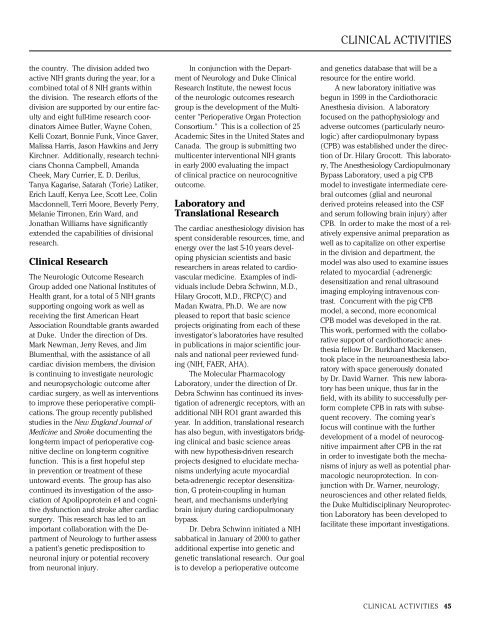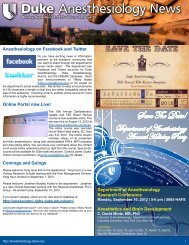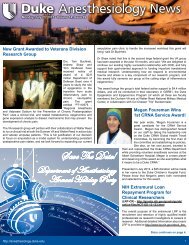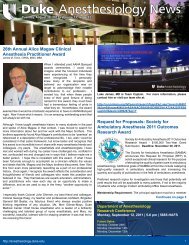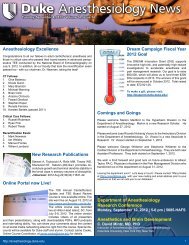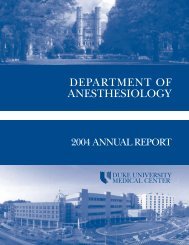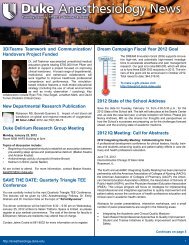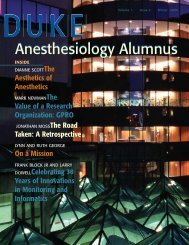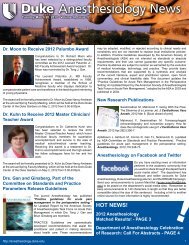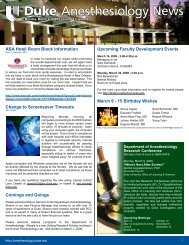DEPARTMENT OF ANESTHESIOLOGY ANNUAL REPORT
DEPARTMENT OF ANESTHESIOLOGY ANNUAL REPORT
DEPARTMENT OF ANESTHESIOLOGY ANNUAL REPORT
Create successful ePaper yourself
Turn your PDF publications into a flip-book with our unique Google optimized e-Paper software.
the country. The division added two<br />
active NIH grants during the year, for a<br />
combined total of 8 NIH grants within<br />
the division. The research efforts of the<br />
division are supported by our entire faculty<br />
and eight full-time research coordinators<br />
Aimee Butler, Wayne Cohen,<br />
Kelli Cozart, Bonnie Funk, Vince Gaver,<br />
Malissa Harris, Jason Hawkins and Jerry<br />
Kirchner. Additionally, research technicians<br />
Chonna Campbell, Amanda<br />
Cheek, Mary Currier, E. D. Derilus,<br />
Tanya Kagarise, Satarah (Torie) Latiker,<br />
Erich Lauff, Kenya Lee, Scott Lee, Colin<br />
Macdonnell, Terri Moore, Beverly Perry,<br />
Melanie Tirronen, Erin Ward, and<br />
Jonathan Williams have significantly<br />
extended the capabilities of divisional<br />
research.<br />
Clinical Research<br />
The Neurologic Outcome Research<br />
Group added one National Institutes of<br />
Health grant, for a total of 5 NIH grants<br />
supporting ongoing work as well as<br />
receiving the first American Heart<br />
Association Roundtable grants awarded<br />
at Duke. Under the direction of Drs.<br />
Mark Newman, Jerry Reves, and Jim<br />
Blumenthal, with the assistance of all<br />
cardiac division members, the division<br />
is continuing to investigate neurologic<br />
and neuropsychologic outcome after<br />
cardiac surgery, as well as interventions<br />
to improve these perioperative complications.<br />
The group recently published<br />
studies in the New England Journal of<br />
Medicine and Stroke documenting the<br />
long-term impact of perioperative cognitive<br />
decline on long-term cognitive<br />
function. This is a first hopeful step<br />
in prevention or treatment of these<br />
untoward events. The group has also<br />
continued its investigation of the association<br />
of Apolipoprotein ε4 and cognitive<br />
dysfunction and stroke after cardiac<br />
surgery. This research has led to an<br />
important collaboration with the Department<br />
of Neurology to further assess<br />
a patient's genetic predisposition to<br />
neuronal injury or potential recovery<br />
from neuronal injury.<br />
In conjunction with the Department<br />
of Neurology and Duke Clinical<br />
Research Institute, the newest focus<br />
of the neurologic outcomes research<br />
group is the development of the Multicenter<br />
"Perioperative Organ Protection<br />
Consortium." This is a collection of 25<br />
Academic Sites in the United States and<br />
Canada. The group is submitting two<br />
multicenter interventional NIH grants<br />
in early 2000 evaluating the impact<br />
of clinical practice on neurocognitive<br />
outcome.<br />
Laboratory and<br />
Translational Research<br />
The cardiac anesthesiology division has<br />
spent considerable resources, time, and<br />
energy over the last 5-10 years developing<br />
physician scientists and basic<br />
researchers in areas related to cardiovascular<br />
medicine. Examples of individuals<br />
include Debra Schwinn, M.D.,<br />
Hilary Grocott, M.D., FRCP(C) and<br />
Madan Kwatra, Ph.D. We are now<br />
pleased to report that basic science<br />
projects originating from each of these<br />
investigator's laboratories have resulted<br />
in publications in major scientific journals<br />
and national peer reviewed funding<br />
(NIH, FAER, AHA).<br />
The Molecular Pharmacology<br />
Laboratory, under the direction of Dr.<br />
Debra Schwinn has continued its investigation<br />
of adrenergic receptors, with an<br />
additional NIH RO1 grant awarded this<br />
year. In addition, translational research<br />
has also begun, with investigators bridging<br />
clinical and basic science areas<br />
with new hypothesis-driven research<br />
projects designed to elucidate mechanisms<br />
underlying acute myocardial<br />
beta-adrenergic receptor desensitization,<br />
G protein-coupling in human<br />
heart, and mechanisms underlying<br />
brain injury during cardiopulmonary<br />
bypass.<br />
Dr. Debra Schwinn initiated a NIH<br />
sabbatical in January of 2000 to gather<br />
additional expertise into genetic and<br />
genetic translational research. Our goal<br />
is to develop a perioperative outcome<br />
CLINICAL ACTIVITIES<br />
and genetics database that will be a<br />
resource for the entire world.<br />
A new laboratory initiative was<br />
begun in 1999 in the Cardiothoracic<br />
Anesthesia division. A laboratory<br />
focused on the pathophysiology and<br />
adverse outcomes (particularly neurologic)<br />
after cardiopulmonary bypass<br />
(CPB) was established under the direction<br />
of Dr. Hilary Grocott. This laboratory,<br />
The Anesthesiology Cardiopulmonary<br />
Bypass Laboratory, used a pig CPB<br />
model to investigate intermediate cerebral<br />
outcomes (glial and neuronal<br />
derived proteins released into the CSF<br />
and serum following brain injury) after<br />
CPB. In order to make the most of a relatively<br />
expensive animal preparation as<br />
well as to capitalize on other expertise<br />
in the division and department, the<br />
model was also used to examine issues<br />
related to myocardial (-adrenergic<br />
desensitization and renal ultrasound<br />
imaging employing intravenous contrast.<br />
Concurrent with the pig CPB<br />
model, a second, more economical<br />
CPB model was developed in the rat.<br />
This work, performed with the collaborative<br />
support of cardiothoracic anesthesia<br />
fellow Dr. Burkhard Mackensen,<br />
took place in the neuroanesthesia laboratory<br />
with space generously donated<br />
by Dr. David Warner. This new laboratory<br />
has been unique, thus far in the<br />
field, with its ability to successfully perform<br />
complete CPB in rats with subsequent<br />
recovery. The coming year’s<br />
focus will continue with the further<br />
development of a model of neurocognitive<br />
impairment after CPB in the rat<br />
in order to investigate both the mechanisms<br />
of injury as well as potential pharmacologic<br />
neuroprotection. In conjunction<br />
with Dr. Warner, neurology,<br />
neurosciences and other related fields,<br />
the Duke Multidisciplinary Neuroprotection<br />
Laboratory has been developed to<br />
facilitate these important investigations.<br />
CLINICAL ACTIVITIES 45


